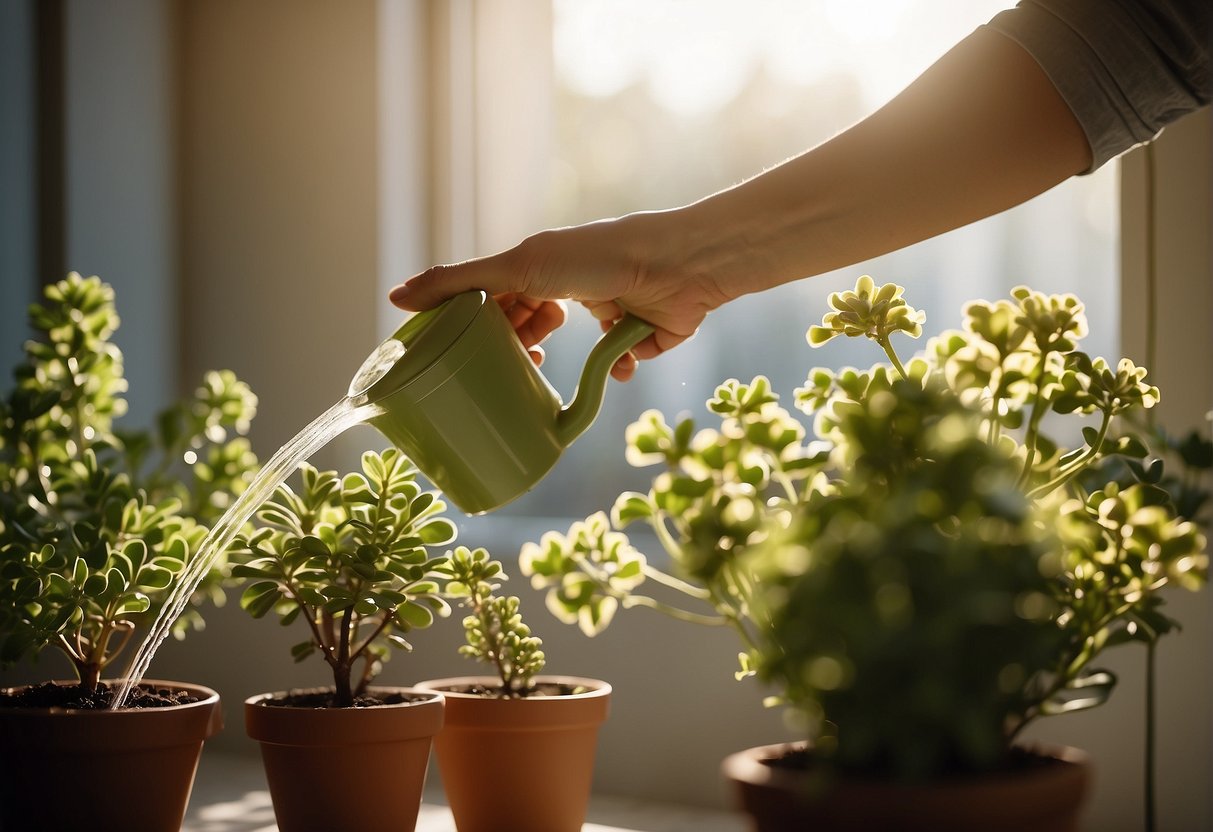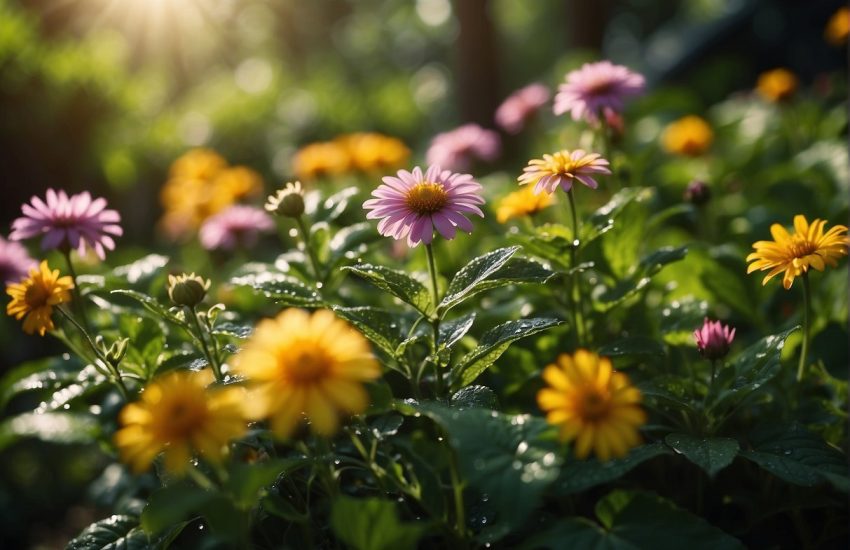Caring for Kalanchoe Plant: Tips and Tricks
Kalanchoe is a popular succulent houseplant that is easy to care for and adds a pop of color to any room. With proper care, these plants can bloom for several weeks, producing clusters of small, brightly colored flowers. However, like any plant, kalanchoe requires specific care to thrive.

One of the most important factors in caring for a kalanchoe plant is providing it with the right amount of light. These plants prefer bright, indirect light, so placing them near a sunny window is ideal. However, direct sunlight can scorch their leaves, so it is important to keep them out of direct sunlight.
Another key aspect of caring for a kalanchoe plant is watering. These succulents are drought-tolerant and do not require frequent watering. In fact, overwatering can be detrimental to their health. It is important to allow the soil to dry out between waterings and to avoid getting water on the leaves, which can cause them to rot. With these tips in mind, anyone can successfully care for a kalanchoe plant and enjoy its beautiful blooms.
Understanding Kalanchoe

Botanical Profile
Kalanchoe is a genus of flowering plants in the family Crassulaceae. It comprises around 125 species of perennial and succulent plants that are native to Madagascar and tropical Africa. The most commonly grown species is Kalanchoe blossfeldiana, also known as Flaming Katy, which is widely cultivated for its colorful flowers.
Kalanchoe plants are known for their fleshy, thick leaves and bright, showy flowers. They can grow up to 1 meter tall and have a spread of up to 50 cm. The leaves are usually green, but some species have leaves that are variegated or have a reddish tinge.
Varieties and Colors
Kalanchoe plants come in a range of colors, including red, pink, yellow, orange, and white. Some popular varieties include ‘Calandiva’, ‘Tessa’, and ‘Flaming Katy’. The flowers are usually small and clustered together in large inflorescences.
Kalanchoe’s Native Habitat
Kalanchoe plants are native to Madagascar and tropical Africa. They are adapted to dry and arid conditions and can store water in their leaves to survive periods of drought. In their native habitat, they grow in rocky outcrops and on cliffs, where they can get plenty of sunlight.
Overall, Kalanchoe plants are easy to care for and make great houseplants. With the right conditions, they can bloom for several weeks, adding a splash of color to any room.
Cultivating Kalanchoe
Optimal Growing Conditions
Kalanchoe is a succulent plant that prefers well-draining soil and full sun. It can grow both indoors and outdoors, but it thrives in a warm and dry environment. The ideal temperature range for kalanchoe is between 60-85°F (15-29°C). It is also important to note that kalanchoe does not require high humidity levels to thrive.
Soil and Repotting
Kalanchoe requires a well-draining soil mix that is rich in nutrients. A mix of peat and perlite is ideal for kalanchoe. Repotting should be done every 2-3 years, or when the plant outgrows its current pot. When repotting, it is important to use a pot that is slightly larger than the current pot to allow the plant to grow.
Watering Requirements
Kalanchoe is a drought-tolerant plant that does not require frequent watering. It is important to allow the soil to dry out between watering sessions to prevent root rot. Overwatering can also lead to the development of fungal diseases. When watering, it is important to water the soil directly and avoid getting water on the leaves.
Light and Temperature
Kalanchoe requires full sun to thrive. It can tolerate partial shade, but it may not bloom as well. When growing indoors, it is important to place the plant near a south-facing window to ensure it receives enough sunlight. It is also important to ensure that the temperature is within the ideal range for kalanchoe.
By following these guidelines, one can cultivate a healthy and thriving kalanchoe plant.
Kalanchoe Propagation Techniques
Kalanchoe plants are easy to propagate and make great gifts for friends and family. There are two main propagation techniques for Kalanchoes: using cuttings and seed propagation.
Using Cuttings
Propagation using cuttings is the most common and easiest method for propagating Kalanchoe plants. In this method, leaf or stem cuttings are taken from the parent plant and placed in soil or water until they develop roots.
Leaf cuttings are taken by carefully removing a healthy leaf from the parent plant and placing it in soil or water. Stem cuttings are taken by cutting a healthy stem from the parent plant and placing it in soil or water.
To propagate using cuttings, follow these steps:
- Choose a healthy leaf or stem from the parent plant
- Cut the leaf or stem at a 45-degree angle
- Place the cutting in soil or water
- Keep the soil moist or change the water regularly
- Wait until the cutting develops roots and a new plant begins to grow
Seed Propagation
Seed propagation is another method of propagating Kalanchoe plants. This method is less common than using cuttings but can be just as effective.
To propagate using seeds, follow these steps:
- Collect seeds from a mature Kalanchoe plant
- Plant the seeds in a well-draining soil mix
- Water the soil regularly to keep it moist
- Keep the soil warm and in a well-lit area
- Wait until the seeds germinate and a new plant begins to grow
In conclusion, Kalanchoe plants can be easily propagated using either cuttings or seed propagation. Both methods are effective and can produce healthy new plants. With a little patience and care, anyone can propagate Kalanchoe plants and create a beautiful nursery.
Maintaining Plant Health

Fertilizing and Nutrients
Kalanchoe plants require regular fertilization to maintain their health and produce vibrant blooms. A balanced fertilizer with equal parts nitrogen, phosphorus, and potassium is ideal for these plants. Fertilize the plant every two weeks during the growing season, and reduce the frequency to once a month during the dormant season.
It is important not to over-fertilize the plant as it can lead to burnt leaves and root damage. Always follow the instructions on the fertilizer packaging and dilute it to half strength before use.
Pruning and Deadheading
Pruning and deadheading are essential for maintaining the plant’s shape and promoting new growth. Prune the plant in early spring to remove any dead or damaged leaves and stems. Deadheading, or removing spent flowers, encourages the plant to produce new blooms.
To deadhead kalanchoe, simply pinch off the spent flowers at their base. Pruning and deadheading should be done with clean, sharp tools to prevent the spread of disease.
Disease and Pest Management
Kalanchoe plants are susceptible to root rot and stem rot, which can be caused by overwatering or poor drainage. To prevent these issues, ensure the plant is planted in well-draining soil and water only when the top inch of soil is dry.
Pests such as mealybugs and spider mites can also infest kalanchoe plants. Regularly inspect the plant for signs of infestation and treat with an insecticidal soap or neem oil if necessary. It is important to follow the instructions on the product label and avoid overuse to prevent damage to the plant.
By following these simple steps, kalanchoe plants can thrive and produce beautiful blooms for years to come.
Troubleshooting Common Issues

Reviving a Wilting Plant
If a Kalanchoe plant is wilting, it may be a sign of underwatering. Check the soil for dryness and water the plant thoroughly if needed. If the plant is still wilting after a few hours, it may be suffering from overwatering or root rot. In this case, it is best to remove the plant from its pot and inspect the roots. Trim away any brown or mushy roots and repot the plant in fresh soil. Water the plant sparingly until it shows signs of recovery.
Preventing Legginess
Kalanchoe plants can become leggy if they are not receiving enough sunlight. To prevent legginess, make sure the plant is receiving adequate light. If the plant is in a low-light area, consider moving it to a brighter location or supplementing with artificial light. Pruning the plant can also encourage bushier growth and prevent legginess.
Addressing Overexposure to Sunlight
While Kalanchoe plants require bright light to thrive, overexposure to direct sunlight can cause sunburn and damage to the leaves. If the plant is showing signs of sunburn, such as brown or yellow spots on the leaves, move it to a shadier location. It is also important to gradually acclimate the plant to direct sunlight if it has been in a low-light area for an extended period of time.
Overall, caring for a Kalanchoe plant is relatively easy as long as its basic needs are met. By addressing common issues such as wilting, legginess, and overexposure to sunlight, the plant can thrive and bring joy to any indoor space.
Frequently Asked Questions

How should I care for a kalanchoe plant indoors to maintain its health?
Kalanchoe plants thrive in bright, indirect sunlight and well-draining soil. Water your plant thoroughly when the top inch of soil feels dry to the touch and avoid overwatering. Fertilize your plant with a balanced fertilizer once a month during the growing season. Keep your kalanchoe away from drafts and extreme temperatures.
What are the best practices for caring for a kalanchoe plant outdoors?
Kalanchoe plants prefer warm temperatures and well-draining soil. Plant your kalanchoe in a location with partial shade to protect it from direct sunlight. Water your plant regularly during the growing season, but allow the soil to dry out between waterings. Fertilize your plant with a balanced fertilizer once a month during the growing season.
How do I protect my kalanchoe plant during the winter months?
Kalanchoe plants are sensitive to cold temperatures and frost. If you live in a cold climate, bring your plant indoors before the first frost. Keep your kalanchoe in a location with bright, indirect sunlight and well-draining soil. Water your plant sparingly during the winter months, allowing the soil to dry out between waterings.
When is the kalanchoe flowering season and how can I encourage blooming?
Kalanchoe plants typically bloom in the winter and early spring. To encourage blooming, provide your plant with bright, indirect sunlight and cooler temperatures. Reduce watering during the fall and winter months to encourage the plant to enter a dormant period. Once buds appear, increase watering and fertilize your plant with a high-phosphorus fertilizer to promote blooming.
What are the steps for propagating kalanchoe plants successfully?
Kalanchoe plants can be propagated from stem cuttings or leaf cuttings. Take a cutting from a healthy plant and allow it to dry out for a few days. Plant the cutting in well-draining soil and water sparingly until roots develop. Once the cutting has established roots, water regularly and fertilize with a balanced fertilizer once a month.
How often should I deadhead my kalanchoe to promote new growth?
Deadheading your kalanchoe regularly can promote new growth and encourage the plant to produce more blooms. Remove spent flowers as soon as they begin to wilt by pinching them off at the base of the stem. Deadheading every few weeks during the growing season can help keep your kalanchoe looking its best.

